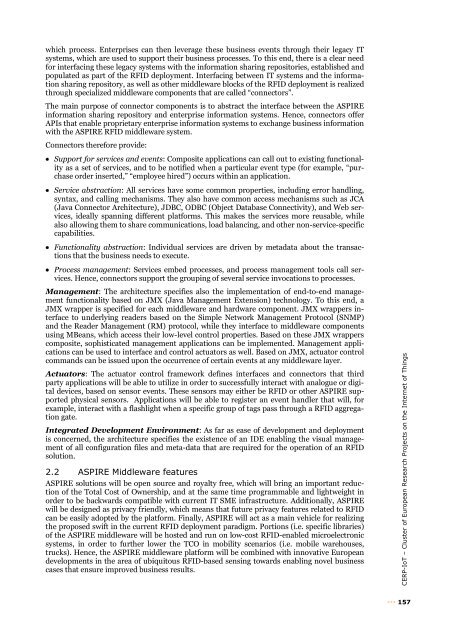Vision and Challenges for Realising the Internet of Things
Vision and Challenges for Realising the Internet of Things
Vision and Challenges for Realising the Internet of Things
Create successful ePaper yourself
Turn your PDF publications into a flip-book with our unique Google optimized e-Paper software.
which process. Enterprises can <strong>the</strong>n leverage <strong>the</strong>se business events through <strong>the</strong>ir legacy IT<br />
systems, which are used to support <strong>the</strong>ir business processes. To this end, <strong>the</strong>re is a clear need<br />
<strong>for</strong> interfacing <strong>the</strong>se legacy systems with <strong>the</strong> in<strong>for</strong>mation sharing repositories, established <strong>and</strong><br />
populated as part <strong>of</strong> <strong>the</strong> RFID deployment. Interfacing between IT systems <strong>and</strong> <strong>the</strong> in<strong>for</strong>mation<br />
sharing repository, as well as o<strong>the</strong>r middleware blocks <strong>of</strong> <strong>the</strong> RFID deployment is realized<br />
through specialized middleware components that are called “connectors”.<br />
The main purpose <strong>of</strong> connector components is to abstract <strong>the</strong> interface between <strong>the</strong> ASPIRE<br />
in<strong>for</strong>mation sharing repository <strong>and</strong> enterprise in<strong>for</strong>mation systems. Hence, connectors <strong>of</strong>fer<br />
APIs that enable proprietary enterprise in<strong>for</strong>mation systems to exchange business in<strong>for</strong>mation<br />
with <strong>the</strong> ASPIRE RFID middleware system.<br />
Connectors <strong>the</strong>re<strong>for</strong>e provide:<br />
Support <strong>for</strong> services <strong>and</strong> events: Composite applications can call out to existing functionality<br />
as a set <strong>of</strong> services, <strong>and</strong> to be notified when a particular event type (<strong>for</strong> example, “purchase<br />
order inserted,” “employee hired”) occurs within an application.<br />
Service abstraction: All services have some common properties, including error h<strong>and</strong>ling,<br />
syntax, <strong>and</strong> calling mechanisms. They also have common access mechanisms such as JCA<br />
(Java Connector Architecture), JDBC, ODBC (Object Database Connectivity), <strong>and</strong> Web services,<br />
ideally spanning different plat<strong>for</strong>ms. This makes <strong>the</strong> services more reusable, while<br />
also allowing <strong>the</strong>m to share communications, load balancing, <strong>and</strong> o<strong>the</strong>r non-service-specific<br />
capabilities.<br />
Functionality abstraction: Individual services are driven by metadata about <strong>the</strong> transactions<br />
that <strong>the</strong> business needs to execute.<br />
Process management: Services embed processes, <strong>and</strong> process management tools call services.<br />
Hence, connectors support <strong>the</strong> grouping <strong>of</strong> several service invocations to processes.<br />
Management: The architecture specifies also <strong>the</strong> implementation <strong>of</strong> end-to-end management<br />
functionality based on JMX (Java Management Extension) technology. To this end, a<br />
JMX wrapper is specified <strong>for</strong> each middleware <strong>and</strong> hardware component. JMX wrappers interface<br />
to underlying readers based on <strong>the</strong> Simple Network Management Protocol (SNMP)<br />
<strong>and</strong> <strong>the</strong> Reader Management (RM) protocol, while <strong>the</strong>y interface to middleware components<br />
using MBeans, which access <strong>the</strong>ir low-level control properties. Based on <strong>the</strong>se JMX wrappers<br />
composite, sophisticated management applications can be implemented. Management applications<br />
can be used to interface <strong>and</strong> control actuators as well. Based on JMX, actuator control<br />
comm<strong>and</strong>s can be issued upon <strong>the</strong> occurrence <strong>of</strong> certain events at any middleware layer.<br />
Actuators: The actuator control framework defines interfaces <strong>and</strong> connectors that third<br />
party applications will be able to utilize in order to successfully interact with analogue or digital<br />
devices, based on sensor events. These sensors may ei<strong>the</strong>r be RFID or o<strong>the</strong>r ASPIRE supported<br />
physical sensors. Applications will be able to register an event h<strong>and</strong>ler that will, <strong>for</strong><br />
example, interact with a flashlight when a specific group <strong>of</strong> tags pass through a RFID aggregation<br />
gate.<br />
Integrated Development Environment: As far as ease <strong>of</strong> development <strong>and</strong> deployment<br />
is concerned, <strong>the</strong> architecture specifies <strong>the</strong> existence <strong>of</strong> an IDE enabling <strong>the</strong> visual management<br />
<strong>of</strong> all configuration files <strong>and</strong> meta-data that are required <strong>for</strong> <strong>the</strong> operation <strong>of</strong> an RFID<br />
solution.<br />
2.2 ASPIRE Middleware features<br />
ASPIRE solutions will be open source <strong>and</strong> royalty free, which will bring an important reduction<br />
<strong>of</strong> <strong>the</strong> Total Cost <strong>of</strong> Ownership, <strong>and</strong> at <strong>the</strong> same time programmable <strong>and</strong> lightweight in<br />
order to be backwards compatible with current IT SME infrastructure. Additionally, ASPIRE<br />
will be designed as privacy friendly, which means that future privacy features related to RFID<br />
can be easily adopted by <strong>the</strong> plat<strong>for</strong>m. Finally, ASPIRE will act as a main vehicle <strong>for</strong> realizing<br />
<strong>the</strong> proposed swift in <strong>the</strong> current RFID deployment paradigm. Portions (i.e. specific libraries)<br />
<strong>of</strong> <strong>the</strong> ASPIRE middleware will be hosted <strong>and</strong> run on low-cost RFID-enabled microelectronic<br />
systems, in order to fur<strong>the</strong>r lower <strong>the</strong> TCO in mobility scenarios (i.e. mobile warehouses,<br />
trucks). Hence, <strong>the</strong> ASPIRE middleware plat<strong>for</strong>m will be combined with innovative European<br />
developments in <strong>the</strong> area <strong>of</strong> ubiquitous RFID-based sensing towards enabling novel business<br />
cases that ensure improved business results.<br />
CERP-IoT – Cluster <strong>of</strong> European Research Projects on <strong>the</strong> <strong>Internet</strong> <strong>of</strong> <strong>Things</strong><br />
157
















